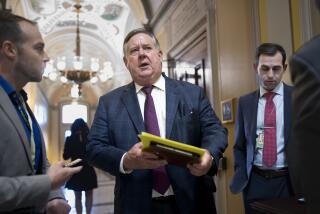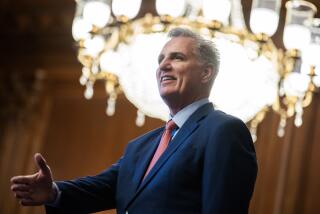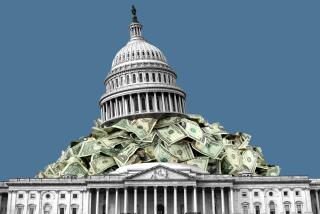Earmarking -- A Win-Win for Lobbyists and Politicians
- Share via
WASHINGTON — Jean Mayer, a renowned nutritionist, had just become president of Tufts University in 1976 when he made an audacious decision: Defying the academy’s disdain for nitty-gritty politics, Mayer agreed to hire a professional lobbyist to try to secure money from Congress to build a nutrition research center.
His hired gun was Gerald S.J. Cassidy, a former Senate aide who had recently started a lobbying business. Cassidy and his partner, rich with political connections, managed to get funding toward a $32-million project set aside for the Massachusetts university in a big congressional bill.
It was an auspicious beginning for Cassidy’s business, and the dawn of a new era in Washington influence-peddling.
Cassidy was pioneering a concept of lobbying that has become part of the warp and woof of Congress: Thousands of lobbyists now earn their keep by seeking rifle-shot appropriations for a particular client, rather than lobbying for programs and policies affecting an entire industry or sector.
This “earmarking” strategy has long been derided as pork-barrel spending and decried by critics such as Sen. John McCain (R-Ariz.). Yet the practice has exploded in recent years. The number of projects earmarked in Congress’ annual appropriations bills has grown from 1,439 in 1995 to nearly 14,000 in 2005, according to the watchdog Citizens Against Government Waste.
Last year’s highway bill alone contained 6,371 projects, according to Taxpayers for Common Sense, another watchdog. By contrast, when President Reagan vetoed a highway bill in 1987, he complained because 152 projects had been inserted.
Earmarking is under new scrutiny as Congress looks for ways to tighten its lobbying and ethics rules in response to recent scandals, including the corruption investigation involving former lobbyist Jack Abramoff.
Critics say that earmarks -- often inserted into bills at the last minute, without public scrutiny or even notice -- are an invitation to corruption because they allow lawmakers to cater to moneyed special interests without accountability.
President Bush last week joined the clamor for a crackdown, saying: “There needs to be earmark reform.”
But earmarking is a prerogative fiercely guarded by lawmakers and by a lucrative lobbying industry that has sprung up around the process.
Thirty years after Cassidy hung out his shingle, Washington’s K Street is now home to a subculture of well-connected lobbyists who make millions by soliciting clients with promises of appropriations -- and by encouraging lawmakers’ belief that such projects will help them win support back home.
According to Taxpayers for Common Sense, the number of firms registered to lobby on budget and appropriations increased from 1,498 in 1998 to 4,013 by mid-2005. Some firms specialize in getting earmarks -- the spokesman for the House Appropriations Committee, John Scofield, calls them “earmark factories.”
“Cassidy knew a good thing when he saw it; others looked over his shoulder,” said one former appropriations aide who now lobbies for earmarks. “Now, everybody’s doing the same thing. We’re all stepping on each other.”
Of all the lobbying restrictions being considered in Congress, elimination of earmarking may be the most difficult to achieve.
Pork-barrel politics has been part of legislative maneuvering for centuries. A traditional part of a lawmaker’s job is to “bring home the bacon.”
Lawmakers also argue that earmarking is part of Congress’ constitutional power of the purse.
“The individual member’s voice in this process is exactly why the people elected us,” said House Appropriations Committee Chairman Jerry Lewis (R-Redlands).
“Earmarking has been going on since the time of George Washington,” said Aimee N. Steel, a spokeswoman for Cassidy. “If Congress chooses to make particular decisions about particular projects rather than have bureaucrats make them, it is perfectly appropriate.”
Generally, Congress directs money toward broad purposes -- highway or school construction, for example -- without singling out individual projects. Then, government agencies judge applicants based more on set criteria than by the political clout of their sponsors.
Specific projects backed by powerful members have often been funded, but earmarking now has become so rampant that even Lewis agrees that the practice has gotten out of control. His panel received 34,687 requests for projects from House members last year.
Lewis last week proposed limiting the number of projects each lawmaker could request and requiring those requests to be made in signed, public letters.
Earmarks have skyrocketed for a number of reasons.
More than a decade ago, while Democrats still controlled Congress, the leaders of some House and Senate appropriations subcommittees -- including Rep. William H. Natcher (D-Ky.) and Sen. William Proxmire (D-Wis.) -- opposed earmarks and kept them out of the bills they oversaw.
Lawmakers had other ways to channel spending to favored projects, such as letters or phone calls to department heads, participants of the era say.
A big change came after Republicans took control of Congress in 1995. James D. Savage, a University of Virginia professor who wrote a book on pork-barrel politics, “Funding Science in America,” said a turning point came a few months before the 1996 elections, when House Speaker Newt Gingrich (R-Ga.) sent a memo to appropriations subcommittee leaders urging them to support projects in politically vulnerable Republicans’ districts. The tactic also had been used by Democrats, but not so widely.
“The green light was given,” said Savage. Today, GOP House leaders send the Appropriations Committee a list of lawmakers they consider to be in peril, giving a boost to funding requests from those members.
As Congress became more willing to use earmarks, legions of lobbyists assembled to shepherd clients through the process. They had seen the spectacular success that Cassidy and his partner, Kenneth Schlossberg, both former aides to Sen. George S. McGovern (D-S.D.), had in building a business around helping colleges.
Cassidy’s role in the appropriations process was not always welcome. When West Virginia University hired his firm to secure money for a research center, the state’s Sen. Robert C. Byrd refused to see the firm’s lobbyist, according to an account in Savage’s book.
“My constituents don’t need a go-between to get my attention,” Democrat Byrd later said.
But enough other lawmakers were ready to do business that Cassidy flourished. After splitting from Schlossberg in 1984, Cassidy built his own firm. He had signed on 87 clients by 1988, most of them institutions of higher education, lobbying records show.
A decade later, the firm was making about $20 million a year lobbying, according to preliminary estimates by the watchdog Center for Responsive Politics.
Now one of the biggest lobbying enterprises in Washington, it made about $195 million through lobbying from 1998 to 2005, the center’s estimates show. The firm’s mission today is far broader than securing earmarks for colleges.
Cassidy’s success shows another element of the relationship between lawmakers and “earmark factories”: To gain and maintain relationships with the people who control the purse strings, lobbyists have become major donors to members of Congress and important figures in the lawmakers’ fundraising machinery.
Cassidy’s employees and associates, for example, have donated more money to 2006 congressional campaigns than any other lobby firm but one, the Center for Responsive Politics says.
According to the Houston Chronicle, the Cassidy firm and one of its lobbyists hosted a fundraiser for Rep. Tom DeLay (R-Texas) two weeks after receiving the first payment under a lobbying contract with the state of Texas.
Democrats said the arrangement turned taxpayer money into political contributions; state officials defended their lobbying contracts as helpful in winning federal grants.
As the Abramoff scandal has unfolded, it has been disclosed that Abramoff was a marketing consultant to Cassidy’s firm briefly in 2004 after being drummed out of his old lobby shop, Greenberg Traurig. Cassidy’s firm says Abramoff was “released” shortly after being hired.
Cassidy no longer has a monopoly on lobbying for earmarks. Van Scoyoc Associates is also known for its appropriations lobbying. The PMA Group emphasizes getting earmarks for defense contractors. Cornerstone Government Affairs has hired many former appropriations committee staffers.
Former appropriations aides are particularly prized for their inside knowledge of the earmarking process. A clubby bipartisan fraternity, they even have an alumni club: the Googol Society (named for the word that means 10 to the hundredth power). They meet twice a year for drinks with current committee staffers.
Appropriations lobbyists do not just wait for clients to come knocking.
For example, someone from Cassidy’s firm a few years ago contacted officials in Boulder City, Nev., to offer help securing federal funds for a new water line after reading about the project in a local paper, Mayor Bob Ferraro said. The city hired the firm for $5,000 a month and, with its help, won millions of dollars for the project.
“They did help us, immensely,” Ferraro said.
Cassidy is still considered the go-to guy for college earmarks. “Almost everybody in higher education knows Cassidy,” said client Francis M. Lazarus, president of the University of Dallas.
Many academic leaders still oppose earmarking, preferring instead to band together to persuade Congress to boost overall spending on higher education and research. This not only helps the schools broadly, the thinking goes, but allows government officials to fund research projects according to the peer review process, which ranks projects on their merits.
But the intensifying competition for limited federal funds is making it hard for purists to stand firm.
The University of California has a policy of not seeking earmarked funds for education and research. But the institution is finding it ever harder to win funding when so much is diverted to earmarked projects, said A. Scott Sudduth, UC’s assistant vice president of federal governmental relations.
“It’s a policy that began to crumble under its own weight,” Sudduth said.
More to Read
Sign up for Essential California
The most important California stories and recommendations in your inbox every morning.
You may occasionally receive promotional content from the Los Angeles Times.












